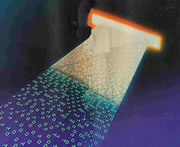| |

Banks and billers face a muddled environment of electronic and paper-based processes.
The latest technology merges mixed payments and streamlines conventional transactions.
|
|
|
|
Cheaper Alternatives that get us all Playing
Cheaper Alternatives that get
us all Playing
"The fees you can charge
for automating remittance can be absolutely sinful," rejoices Tom Houston
of T. Houston Group. "And don't assume that smaller community banks
can't get into this game. Sure the market for full fledged EBPP-based implementations
by big companies like CheckFree is viable, but EBPP is a rich man's game, currently
priced out of the reach of millions of small business and community banks.
Fortunately, you don't need expensive state-of-the-art equipment to provide
better remittance systems."
Houston points out that half of all the community banks
in the United States have implemeted in-house check imaging systems to speed
up the process of handling remittances. This provides banks with a hugh opportunity
because, " very few of the water and sewage companies, tax collection agencies,
and cable television companies those banks service have this sort of technology
in place. Community banks have got to start learning to sell the services they
have mastered so well," says Houston.
Patrick Koster, marketing director of BankWare of Birmingham
Alabama agrees. "Community banks are beginning to understand how they can
use existing technology to help customers process payments more efficiently.
They sign up to handle remittance processing for the local water company and
real estate management firm. They set up lockboxes at the local post
office for all their business customers. Each morning a bank employee collects
all the bills, checks and invoices delivered to those boxes. The bank takes
these paper documents, uses its high speed imaging system to capture and organize
those documents efficiently, and then transmits summaries and images or all
the captured documents to the corporate customer." The end result is
lower operating costs and faster payment delivery for both the bank and the
biller.
It is wonderful opportunity for those willing to seize it
advises Tom Houston. "Remember it takes
the big boys forever to get anything done. In the year or two it's going to
take for the big guys to work out the political hurdles faced by EBPP, smaller
community banks will be working hard putting remittance solutions into place.
Get those systems in place and working well today and it is going to be very
hard for the big guys to convince your customers to move to their new fangled
EBPP system tomorrow.
EBPP Solutions for Community
Banks
Although Tom Houston strongly advocates use of image-enabled
remittance systems at community banks, he realizes that some of those banks
will want to make the bigger leap into the august EBPP world.
"The key to pulling EBPP off at a smaller bank is to
pool your resources with other like-minded institutions. "The cost for
implementing EBPP ranges from $350,000 to $750,000 - too expensive for most
community banks. Because of the enormous start-up costs, most community banks
will turn to service bureaus for these services. Another alternative is creating
a 'co-op' of similar size banks to share the costs. It will cost about $3,000,000
to implement such a system for one hundred banks. That means the cost per bank
drops is a quite affordable $30,000. In this range, most community banks can
afford the technology, but they have to be willing to negotiate the difficult
political issues associated with working closely with other community banks."
|



